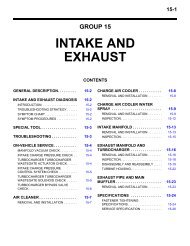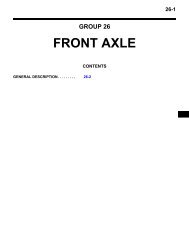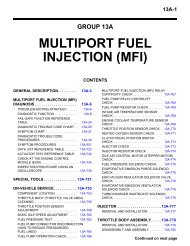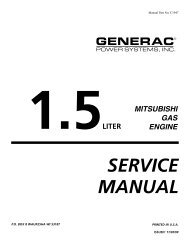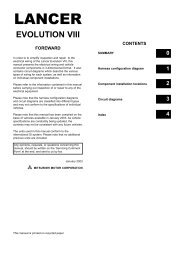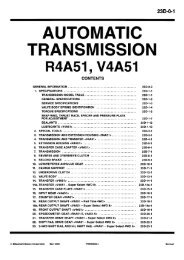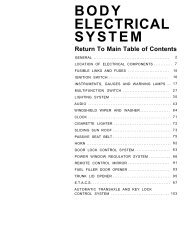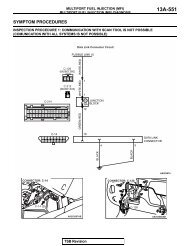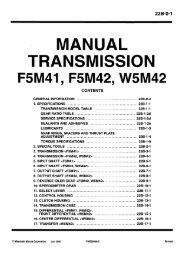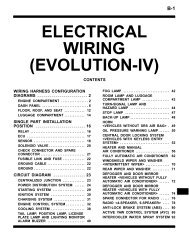SUSPENSION - REAR Article Text - Webs
SUSPENSION - REAR Article Text - Webs
SUSPENSION - REAR Article Text - Webs
You also want an ePaper? Increase the reach of your titles
YUMPU automatically turns print PDFs into web optimized ePapers that Google loves.
<strong>SUSPENSION</strong> - <strong>REAR</strong><br />
<strong>Article</strong> <strong>Text</strong><br />
1992 Mitsubishi Mirage<br />
For a a a a a<br />
Copyright © 1998 Mitchell Repair Information Company, LLC<br />
Monday, April 01, 2002 10:19AM<br />
ARTICLE BEGINNING<br />
1992 <strong>SUSPENSION</strong><br />
Chrysler Motors/Mitsubishi Rear Suspension<br />
Chrysler Motors: Colt, Colt 200, Colt Vista, Stealth,<br />
Summit, Summit Wagon<br />
Mitsubishi: Diamante, Eclipse, Expo/Expo LRV,<br />
Galant, Mirage, Precis, 3000GT<br />
DESCRIPTION<br />
NOTE:<br />
Diamante, Galant, Stealth and 3000GT may be equipped with<br />
Electronically Controlled Suspension (ECS). The suspension<br />
remains the same, but it is electronically controlled. For<br />
testing and diagnosis information on electronically<br />
controlled suspension, see appropriate ELECTRONIC <strong>SUSPENSION</strong><br />
article in the <strong>SUSPENSION</strong> Section.<br />
Colt, Colt 200, Eclipse FWD, Galant FWD, Mirage & Summit<br />
Rear suspension system is a 3-link type with "U"-shaped<br />
torsion axle beam. See Fig. 1.<br />
Diamante, Stealth FWD & 3000GT FWD<br />
Rear suspension system is multi-link type with hydraulic<br />
shock absorbers, coil springs and stabilizer bar. See Fig. 2.<br />
Eclipse AWD, Galant AWD, Stealth AWD & 3000GT AWD<br />
Rear suspension system is an independent, double-wishbone<br />
type. System consists of upper and lower suspension arms, shock<br />
absorbers, coil springs and stabilizer bar. See Fig. 3.<br />
Colt Vista FWD, Expo/Expo LRV FWD & Summit Wagon FWD<br />
Rear suspension is an independent trailing arm type. System<br />
consists of low profile coil springs, suspension arms and shock<br />
absorbers. See Fig. 4.<br />
Colt Vista AWD, Expo/Expo LRV AWD & Summit Wagon AWD<br />
Rear suspension is an independent trailing arm type. System<br />
consists of low profile coil springs, suspension arms, shock absorbers<br />
and a stabilizer bar. See Fig. 5.<br />
Precis<br />
Rear suspension is an independent trailing arm type,<br />
consisting of an integral axle, suspension arms, shock absorbers, coil<br />
springs and stabilizer bar. See Fig. 6. Torsion bar is inside axle<br />
beam and not removable.
<strong>SUSPENSION</strong> - <strong>REAR</strong><br />
<strong>Article</strong> <strong>Text</strong> (p. 2)<br />
1992 Mitsubishi Mirage<br />
For a a a a a<br />
Copyright © 1998 Mitchell Repair Information Company, LLC<br />
Monday, April 01, 2002 10:19AM<br />
Fig. 1: Exploded View Of Rear Suspension (Eclipse FWD Shown;<br />
Colt, Colt 200, Galant FWD, Mirage & Summit Are Similar)<br />
Courtesy of Mitsubishi Motor Sales of America.<br />
Fig. 2: Exploded View Of Rear Suspension (Diamante, Stealth FWD &<br />
3000GT FWD)<br />
Courtesy of Mitsubishi Motor Sales of America.
<strong>SUSPENSION</strong> - <strong>REAR</strong><br />
<strong>Article</strong> <strong>Text</strong> (p. 3)<br />
1992 Mitsubishi Mirage<br />
For a a a a a<br />
Copyright © 1998 Mitchell Repair Information Company, LLC<br />
Monday, April 01, 2002 10:19AM<br />
Fig. 3: Exploded View Of Rear Suspension (Eclipse AWD & Galant<br />
AWD Shown; Stealth AWD & 3000GT AWD Are Similar)<br />
Courtesy of Mitsubishi Motor Sales of America.<br />
Fig. 4: Exploded View Of Rear Suspension (Expo/Expo LRV FWD<br />
Shown; Colt Vista FWD & Summit Wagon FWD Are Similar)<br />
Courtesy of Mitsubishi Motor Sales of America.
<strong>SUSPENSION</strong> - <strong>REAR</strong><br />
<strong>Article</strong> <strong>Text</strong> (p. 4)<br />
1992 Mitsubishi Mirage<br />
For a a a a a<br />
Copyright © 1998 Mitchell Repair Information Company, LLC<br />
Monday, April 01, 2002 10:19AM<br />
Fig. 5: Exploded View Of Rear Suspension (Colt Vista AWD,<br />
Expo/Expo LRV AWD & Summit Wagon AWD)<br />
Courtesy of Mitsubishi Motor Sales of America.<br />
Fig. 6: Exploded View Of Rear Suspension (Precis)<br />
Courtesy of Mitsubishi Motor Sales of America.<br />
ADJUSTMENTS & INSPECTION<br />
WHEEL ALIGNMENT SPECIFICATIONS & PROCEDURES
<strong>SUSPENSION</strong> - <strong>REAR</strong><br />
<strong>Article</strong> <strong>Text</strong> (p. 5)<br />
1992 Mitsubishi Mirage<br />
For a a a a a<br />
Copyright © 1998 Mitchell Repair Information Company, LLC<br />
Monday, April 01, 2002 10:19AM<br />
NOTE:<br />
See SPECIFICATIONS & PROCEDURES article in the WHEEL<br />
ALIGNMENT Section.<br />
WHEEL BEARING<br />
1) Raise and support vehicle. Remove rear wheel assembly.<br />
Remove brake disc or drum if necessary. Measure axle shaft end play<br />
using dial indicator. See AXIAL END PLAY & ROTARY SLIDING RESISTANCE<br />
SPECIFICATIONS table.<br />
2) If end play exceeds limit, retighten wheel bearing nut or<br />
companion flange nut (if equipped) to specification. See appropriate<br />
TORQUE SPECIFICATIONS table at end of article. DO NOT back off wheel<br />
bearing nut more than 15 degrees to align cotter pin holes (if<br />
equipped). Recheck end play. If end play exceeds limit, replace wheel<br />
bearings.<br />
3) Check rotary sliding resistance. Attach a spring scale to<br />
hub bolt. Measure rotary sliding resistance by pulling spring scale at<br />
a90-degree angle to hub bolt. Note measurement when hub begins to<br />
rotate. See AXIAL END PLAY & ROTARY SLIDING RESISTANCE SPECIFICATIONS<br />
table. If resistance exceeds limit, replace wheel bearing.<br />
AXIAL END PLAY & ROTARY SLIDING RESISTANCE SPECIFICATIONS<br />
End Play<br />
Rotary Resistance<br />
Application In. (mm) Lbs. (kg)<br />
Colt, Colt 200, Mirage &<br />
Summit ................. .0080 (.200) ................ 4.9 (2.2)<br />
Eclipse FWD .............. .0040 (.100) ................ 7.0 (3.1)<br />
Eclipse AWD, Galant AWD,<br />
Stealth AWD &<br />
3000GT AWD ............ .0310 (.790) ................ 2.6 (1.2)<br />
Colt Vista FWD,<br />
Expo/Expo LRV FWD &<br />
Summit Wagon FWD ...... .0020 (.050) ................ 4.0 (1.8)<br />
Galant FWD, Stealth FWD &<br />
3000GT FWD<br />
Disc Brakes ........... .0020 (.050) ................ 7.0 (3.1)<br />
Drum Brakes ........... .0000 (.000) ............ (1) 3.1 (1.4)<br />
Precis ................... .0043 (.110) ................ 4.8 (2.1)<br />
In. (mm)<br />
INCH Lbs. (N.m)<br />
Colt Vista AWD,<br />
Expo/Expo LRV AWD &<br />
Summit Wagon AWD ....... .002 (.05) ................... 9 (1.1)<br />
(1) - Specification given is for new bearing testing. If testing<br />
an old bearing, maximum resistance is 2.42 lbs. (1.1 kg).<br />
REMOVAL & INSTALLATION
<strong>REAR</strong> <strong>SUSPENSION</strong> ASSEMBLY<br />
<strong>SUSPENSION</strong> - <strong>REAR</strong><br />
<strong>Article</strong> <strong>Text</strong> (p. 6)<br />
1992 Mitsubishi Mirage<br />
For a a a a a<br />
Copyright © 1998 Mitchell Repair Information Company, LLC<br />
Monday, April 01, 2002 10:19AM<br />
Removal (Colt, Colt 200, Eclipse FWD, Diamante, Galant FWD,<br />
Mirage, Stealth FWD, Summit & 3000GT)<br />
1) On all models except Eclipse, remove trunk side trim. On<br />
Eclipse FWD, remove hole cover. On all models, raise and support<br />
vehicle. Remove wheel assembly.<br />
2) On models equipped with disc brakes, remove caliper and<br />
disc assembly. See Fig. 1 or 2. On all models, remove cotter pin, lock<br />
cap, lock nut, washer and outer bearing (components vary between<br />
applications). Remove hub assembly or brake drum assembly (depending<br />
on application). Remove dust cover (if equipped).<br />
3) Disconnect and remove rear speed sensor (if equipped).<br />
Disconnect parking brake cable from brake assembly and torsion axle<br />
and arm assembly. Remove brake assembly. Disconnect brake hose. Remove<br />
brake hose bracket from torsion axle and arm assembly.<br />
4) On Galant with electronically controlled suspension,<br />
disconnect rear height sensor rod from lateral rod. Remove tube, "O"<br />
ring, dust cover, actuator and adapter. Cover open lines and fittings<br />
using vinyl tape.<br />
5) On all other models, remove dust cap from top of shock<br />
assembly. See Fig. 1 or 2. On all models, slightly raise torsion axle<br />
and arm assembly using a floor jack. Remove upper and lower shock<br />
absorber mounting nuts. Remove shock absorber. Disconnect lateral rod<br />
from body. Remove trailing arm bolts. Lower jack, and remove rear<br />
suspension assembly from vehicle.<br />
Inspection<br />
Check axle beam, lateral rod and trailing arm for deformation<br />
and damage. Check rubber bushings for deterioration, cracks and<br />
unusual wear.<br />
Installation<br />
1) If trailing arm bushing needs replacing, remove bushing<br />
using Bushing Press (MB991045 for Colt, Colt 200, Diamante, Mirage,<br />
Stealth, Summit and 3000GT; MB991159 for Eclipse FWD and Galant FWD).<br />
Remove lateral rod bushing using Driver (MB990947-01) and Adapters<br />
(MB990847-01 and MB990845-01).<br />
2) Press in new arm bushing from beveled side of housing.<br />
Ensure slots in bushing face front-to-rear. Press in new lateral rod<br />
bushing using driver. Ensure bushing protrudes equally on both sides.<br />
3) To complete installation, reverse removal procedure. Bleed<br />
brakes, and check wheel bearings. See WHEEL BEARING under ADJUSTMENTS<br />
& INSPECTION. Tighten all fasteners to specification. See TORQUE<br />
SPECIFICATIONS (FWD) table at end of article. Check wheel alignment.<br />
Removal (Colt Vista, Eclipse AWD, Expo/Expo LRV, Galant AWD,<br />
Stealth AWD, Summit Wagon & 3000GT AWD)<br />
1) On Colt Vista, Eclipse, Expo/Expo LRV and Summit Wagon<br />
remove shock/strut access cover. On Galant, Stealth and 3000GT, remove<br />
trunk room trim. On all models, remove center exhaust pipe and main<br />
muffler.
<strong>SUSPENSION</strong> - <strong>REAR</strong><br />
<strong>Article</strong> <strong>Text</strong> (p. 7)<br />
1992 Mitsubishi Mirage<br />
For a a a a a<br />
Copyright © 1998 Mitchell Repair Information Company, LLC<br />
Monday, April 01, 2002 10:19AM<br />
2) Remove shock absorber upper mounting nuts. On vehicles<br />
with electronically controlled suspension, disconnect electrical<br />
connector and remove cap from top of shock.<br />
3) On all models, remove brake tube bracket bolt. Disconnect<br />
parking brake. Remove caliper lock pin. Rotate caliper upward, and<br />
remove caliper assembly and brake disc. Secure caliper assembly aside<br />
using wire. Cover guide pin using a cloth.<br />
4) On Stealth and 3000GT with 4-wheel steering, disconnect<br />
pressure tubes, feed, suction and return lines. Remove power cylinder<br />
tie rod coupling nut. On models with anti-lock brakes, disconnect<br />
electrical harness connectors.<br />
5) On all models, mark drive shaft flange and differential<br />
flange for installation reference. Disconnect drive shaft, and secure<br />
it using wire. Support differential using transaxle jack, and remove<br />
self-locking nuts.<br />
6) Remove differential support member. Remove crossmember<br />
bracket. Lower transaxle jack slightly, and remove parking brake cable<br />
and rear speed sensor bolts. Remove cable band. Remove rear speed<br />
sensor connector and "O" ring (if equipped).<br />
CAUTION: Ensure drive shaft does not bend excessively. Due to weight<br />
being handled, 3 people are required to lower suspension<br />
assembly.<br />
7) Move suspension assembly toward rear of vehicle, and<br />
slowly lower suspension assembly. DO NOT contact stabilizer bar and<br />
drive shaft. Support lower arm using a wooden block to protect dust<br />
shield.<br />
Inspection<br />
Check crossmember for cracks and other damage. Inspect all<br />
components for damage and unusual wear. Replace components as<br />
necessary.<br />
Installation<br />
To install, reverse removal procedure. Ensure reference marks<br />
align when installing drive shaft. Tighten all suspension fasteners to<br />
specification with vehicle on ground and suspension unloaded. See<br />
appropriate TORQUE SPECIFICATIONS table at end of article. Check wheel<br />
alignment.<br />
Removal (Precis)<br />
1) Drain brake fluid. Raise and support vehicle. Remove wheel<br />
assembly. Remove brake drum and wheel bearings. Disconnect brake lines<br />
and parking brake cable. Remove brake assembly. Remove muffler and<br />
pipe.<br />
2) Raise suspension slightly using floor jack. Disconnect<br />
shock absorbers from suspension arms. See Fig. 6. Lower suspension<br />
enough to remove coil springs and seats. Remove fixture-to-body bolts.<br />
Remove suspension assembly.<br />
Disassembly
<strong>SUSPENSION</strong> - <strong>REAR</strong><br />
<strong>Article</strong> <strong>Text</strong> (p. 8)<br />
1992 Mitsubishi Mirage<br />
For a a a a a<br />
Copyright © 1998 Mitchell Repair Information Company, LLC<br />
Monday, April 01, 2002 10:19AM<br />
1) Scribe alignment marks on fixture-to-suspension arm<br />
position for reassembly reference. Scribe mark on stabilizer bar in<br />
alignment with punch mark on stabilizer bar bracket for reassembly<br />
reference.<br />
2) Remove fixture retaining nuts at both ends of suspension<br />
arm. Remove fixtures and rubber bushings. Note position of rubber<br />
bushings. Remove dust cover clamp, and slide dust cover toward right<br />
suspension arm. DO NOT damage dust cover.<br />
3) Separate suspension into right and left arms. Remove<br />
stabilizer bar. See Fig. 6. Remove rubber stoppers. Using a<br />
screwdriver and hammer, drive out bushing "A" from left suspension<br />
arm. Drive bushing "B" from left suspension arm.<br />
Inspection<br />
Check for bent or damaged suspension arm, dust cover, rubber<br />
stopper and damaged or worn bushings. Replace components as necessary.<br />
Reassembly<br />
1) If dust cover is replaced, slide new dust cover up to<br />
stopper on right suspension arm. Apply grease to outside of right<br />
suspension arm. Using right suspension arm, install rubber stopper<br />
into left suspension arm.<br />
2) Apply grease to outer surfaces of bushings "A" and "B".<br />
Using Bushing Installer (MB990780) and Handle (MB990779), install<br />
bushing "B" until bushing bottoms in arm. Install bushing "A" using<br />
bushing installer. Install stabilizer bar. Slowly push suspension arms<br />
together, and wipe away excess grease.<br />
3) Ensure stabilizer bar mark aligns with punch mark on<br />
stabilizer bar bracket. Install inner and outer rubber bushings,<br />
fixtures and washers. DO NOT apply grease to bushings or shaft<br />
threads.<br />
4) Ensure toothed side of washer faces bushing and cutout<br />
area of fixture faces forward. Install fixtures and suspension arm in<br />
original positions. Align marks scribed during disassembly. Install<br />
nuts.<br />
5) Tighten nuts to specification with vehicle at normal<br />
operating height and no load. See TORQUE SPECIFICATIONS (FWD) table at<br />
end of article. Pack dust cover with grease, and secure using new<br />
clamp.<br />
Installation<br />
1) To install, reverse removal procedure. Check upper and<br />
lower spring seats for proper installation. Tighten bolts to<br />
specification. See TORQUE SPECIFICATIONS (FWD) table at end of<br />
article.<br />
2) Tighten suspension arm nuts and shock absorber bolts to<br />
specification with vehicle at normal operating height and no load.<br />
Check wheel bearings (if required). See WHEEL BEARING under<br />
ADJUSTMENTS & INSPECTION. Bleed and adjust brakes. Check wheel<br />
alignment.<br />
SHOCK ABSORBERS
<strong>SUSPENSION</strong> - <strong>REAR</strong><br />
<strong>Article</strong> <strong>Text</strong> (p. 9)<br />
1992 Mitsubishi Mirage<br />
For a a a a a<br />
Copyright © 1998 Mitchell Repair Information Company, LLC<br />
Monday, April 01, 2002 10:19AM<br />
Removal (Except Precis)<br />
1) On Colt, Colt 200, Mirage and Summit hatchback models,<br />
remove trunk side trim. On Diamante, Eclipse, Galant, Stealth and<br />
3000GT, remove trunk side trim or shock/strut access cover. On Colt<br />
Vista, Expo/Expo LRV and Summit Wagon, remove shock/strut access<br />
cover.<br />
2) On all models, raise and support vehicle. Remove wheel<br />
assembly. Support lower arm assembly using jack stands. On models with<br />
electronically controlled suspension, disconnect electrical connector<br />
from top of shock and remove actuator.<br />
CAUTION: On models with spring assisted shock absorbers, DO NOT<br />
remove center strut rod nut until spring is compressed.<br />
3) On all models, remove dust cap from top of shock assembly.<br />
Raise lower arm assembly using a jack. Remove mount nuts, and<br />
disconnect upper shock mount from body. Disconnect shock from lower<br />
arm assembly. Lower jack, and remove shock assembly from vehicle.<br />
Inspection<br />
Check shock for oil leakage, abnormal noise and poor<br />
function. Check coil spring for bending and weakness. Check rubber<br />
parts for deterioration and cracks. Check suspension arm and spindle<br />
for cracks and deformation.<br />
Installation<br />
To install, reverse removal procedure. Tighten all fasteners<br />
to specification. See appropriate TORQUE SPECIFICATIONS table at end<br />
of article. Check wheel alignment.<br />
Removal (Precis)<br />
Support suspension arm using jack. Remove lower shock<br />
absorber mounting bolt (if necessary, remove brake assembly). Lower<br />
jack slowly, and remove coil springs and seats. Remove upper shock<br />
absorber mounting bolts, and remove shock.<br />
Inspection<br />
Check shocks for oil leakage, abnormal noise and poor<br />
function. Check coil springs for bending and weakness. Check rubber<br />
parts for deterioration and cracks. Check suspension arm and spindle<br />
for cracks and deformation.<br />
Installation<br />
To install, reverse removal procedure. Tighten all fasteners<br />
to specification. See TORQUE SPECIFICATIONS (FWD) table at end of<br />
article.<br />
STABILIZER BAR<br />
Removal (Colt Vista AWD, Diamante, Eclipse AWD, Expo/Expo LRV<br />
AWD, Galant AWD, Stealth, Summit Wagon AWD & 3000GT)
<strong>SUSPENSION</strong> - <strong>REAR</strong><br />
<strong>Article</strong> <strong>Text</strong> (p. 10)<br />
1992 Mitsubishi Mirage<br />
For a a a a a<br />
Copyright © 1998 Mitchell Repair Information Company, LLC<br />
Monday, April 01, 2002 10:19AM<br />
1) Raise and support vehicle. Support rear suspension<br />
assembly using a transaxle jack. Remove self-locking nuts and<br />
crossmember brackets. Remove bracket bolt for parking brake cable and<br />
speed sensor cable (if equipped).<br />
2) Remove stabilizer bar bracket and bushings. Remove<br />
stabilizer link nut. Remove lower joint cups and stabilizer rubber.<br />
Remove stabilizer link-to-stabilizer bar nut, and remove stabilizer<br />
link. Lower transaxle jack slightly, and remove stabilizer bar.<br />
Inspection<br />
1) Check bushings for wear and deterioration. Check<br />
stabilizer bar, stabilizer link and all bolts for damage and wear.<br />
Check ball joint dust cover for cracks. Replace components as<br />
necessary.<br />
2) If ball joint dust cover needs replacing, remove clip ring<br />
and dust cover. Pack new dust cover with grease. Wrap stud threads<br />
using vinyl tape, and install dust cover. Secure cover using clip<br />
ring.<br />
3) Check stabilizer link ball joint starting torque. Deflect<br />
ball joint stud from side to side several times. Install 2 nuts on<br />
ball joint. Measure ball joint starting torque using INCH lb. torque<br />
wrench.<br />
4) Starting torque should be 15-28 INCH lbs. (1.7-3.2 N.m).<br />
If starting torque exceeds specification, replace link. If ball joint<br />
starting torque is less than specification, ball joint may be reused<br />
unless it has drag and excessive play.<br />
Installation<br />
To install, reverse removal procedure. When installing<br />
stabilizer link, hold link using a wrench and tighten nut until<br />
distance from end of bolt to edge of nut is within specification. See<br />
STABILIZER LINK SPECIFICATIONS table. Tighten all remaining fasteners<br />
to specification. See appropriate TORQUE SPECIFICATIONS table at end<br />
of article.<br />
STABILIZER LINK SPECIFICATIONS TABLE<br />
Application<br />
Distance<br />
In. (mm)<br />
Diamante, Stealth & 3000GT ..................... 0.20-0.28 (5.1-7.1)<br />
Eclipse AWD & Galant AWD ...................... 0.35-0.43 (8.9-11.0)<br />
Colt Vista AWD, Expo/Expo LRV AWD &<br />
Summit Wagon AWD ........................... 0.98-1.06 (24.9-26.9)<br />
Removal & Installation (Precis)<br />
See <strong>REAR</strong> <strong>SUSPENSION</strong> ASSEMBLY.<br />
TRAILING ARM<br />
Removal (Eclipse AWD, Galant AWD, Stealth AWD & 3000GT AWD)
<strong>SUSPENSION</strong> - <strong>REAR</strong><br />
<strong>Article</strong> <strong>Text</strong> (p. 11)<br />
1992 Mitsubishi Mirage<br />
For a a a a a<br />
Copyright © 1998 Mitchell Repair Information Company, LLC<br />
Monday, April 01, 2002 10:19AM<br />
1) Disconnect parking brake cable end. Remove bracket for<br />
parking brake cable and speed sensor cable (if equipped). Remove rear<br />
brake assembly, and suspend caliper using wire. Remove brake disc.<br />
2) Disconnect drive axle from axle shaft companion flange.<br />
Hold hub using Yoke Holder (MB990767-01), and remove companion flangeto-axle<br />
shaft nut. Remove companion flange. Remove rear speed sensor<br />
and "O" ring (if equipped). Loosen upper and lower arm ball joint<br />
nuts, and disconnect ball joints.<br />
3) Remove trailing arm installation nut and bolt. Disconnect<br />
shock absorber from trailing arm. Remove trailing arm. Check trailing<br />
arm and bushing for cracks, deterioration and wear. Replace components<br />
as necessary.<br />
Disassembly<br />
1) Using Bushing Arbor (MB990849) and Base (MB990646), remove<br />
bushing. Remove connecting rod bolt and nut. Install Rod<br />
Remover/Installer (MB991254) on trailing arm.<br />
2) Apply lubricant to sliding areas marked "A" in Fig. 7.<br />
Install bolt "B" to trailing arm at point shown. Turn threaded shaft<br />
"C" on remover/installer to remove connecting rod.<br />
Fig. 7: Removing Connecting Rod From Front Trailing Arm (Eclipse<br />
AWD, Galant AWD, Stealth AWD & 3000GT AWD)<br />
Courtesy of Mitsubishi Motor Sales of America.<br />
Reassembly<br />
If trailing arm bushing needs replacement, use bushing arbor<br />
and base to install new bushing. Press fit bushing until bushing outer<br />
pipe edge is flush with lower arm pipe edge. To complete reassembly,<br />
reverse disassembly procedure. Apply soapy water to rubber portion of<br />
connecting rod.<br />
Installation<br />
To install trailing arm, reverse removal procedure. Tighten<br />
all fasteners to specification. See appropriate TORQUE SPECIFICATIONS<br />
table at end of article. Check wheel alignment.<br />
UPPER & LOWER ARMS
<strong>SUSPENSION</strong> - <strong>REAR</strong><br />
<strong>Article</strong> <strong>Text</strong> (p. 12)<br />
1992 Mitsubishi Mirage<br />
For a a a a a<br />
Copyright © 1998 Mitchell Repair Information Company, LLC<br />
Monday, April 01, 2002 10:19AM<br />
NOTE:<br />
Coil springs have color marks for spring identification and<br />
load classification. When replacing springs, ensure markings<br />
are correct for appropriate vehicle.<br />
Removal (Eclipse AWD, Galant AWD, Stealth AWD & 3000GT AWD)<br />
Loosen upper arm ball joint nut, and disconnect upper arm<br />
ball joint. Remove upper arm bolt and arm. Loosen lower arm ball joint<br />
nut, and disconnect lower arm ball joint. Hold stabilizer link using a<br />
wrench, and remove stabilizer link nut. Disconnect link from lower<br />
arm. Remove lower arm bolt, and remove lower arm.<br />
Inspection<br />
1) Check bushing for wear and deterioration. Check upper and<br />
lower arms for bends and breakage. Check ball joint dust covers for<br />
cracks. Check all bolts for wear and damage. Replace components as<br />
necessary.<br />
2) Check ball joint starting torque. Deflect ball joint stud<br />
side to side several times. Install 2 nuts on ball joint. Using INCH<br />
lb. torque wrench, measure ball joint starting torque. Starting torque<br />
should be 17-78 INCH lbs. (2-9 N.m). If starting torque exceeds<br />
specification, replace arm. If ball joint starting torque is less than<br />
specification, ball joint may be reused unless it has drag and<br />
excessive play.<br />
Installation<br />
1) If ball joint dust cover needs replacement, remove dust<br />
cover and apply grease to lip and inside of new dust cover. Install<br />
dust cover using Installer (MB990800). Ensure dust cover is fully<br />
seated.<br />
2) If lower arm bushing needs replacement, use Bushing Arbor<br />
(MB991246), Bushing Ring (MB991245) and Base (MB990847) to remove and<br />
install bushing. Press fit bushing until bushing outer edge is flush<br />
with lower arm edge.<br />
3) To complete installation, reverse removal procedure. When<br />
installing stabilizer link, hold link using a wrench and tighten nut<br />
until distance from end of bolt to edge of nut is as specified. See<br />
STABILIZER LINK SPECIFICATIONS table under STABILIZER BAR. Tighten<br />
upper and lower arm nuts to specification. See appropriate TORQUE<br />
SPECIFICATIONS table at end of article. Check wheel alignment.<br />
Removal (Colt Vista, Expo/Expo LRV & Summit Wagon)<br />
1) Support lower arm using floor jack. Remove shock absorber<br />
from lower arm. See Fig. 4 or 5. Scribe mark coil spring and lower arm<br />
for installation reference. Slowly lower jack to remove tension from<br />
coil spring, and remove coil spring. Remove stabilizer bar (AWD<br />
models). See STABILIZER BAR. Remove brake drum or caliper assembly and<br />
disc. Remove hub assembly.<br />
2) Remove parking brake cable end. Remove parking brake cable<br />
bracket from lower arm. Scribe mark lower arm cam bolts for<br />
installation reference. Remove crossmember-to-lower arm flange and cam<br />
bolts. Remove lower arm from vehicle.
<strong>SUSPENSION</strong> - <strong>REAR</strong><br />
<strong>Article</strong> <strong>Text</strong> (p. 13)<br />
1992 Mitsubishi Mirage<br />
For a a a a a<br />
Copyright © 1998 Mitchell Repair Information Company, LLC<br />
Monday, April 01, 2002 10:19AM<br />
Inspection<br />
Check lower arm for deformation and deterioration. Check all<br />
bolts for condition and straightness. Check spring seats for cracks<br />
and wear. Check bushings for cracking and deterioration.<br />
Disassembly<br />
If lower arm bushings need replacement, scribe mark lower<br />
arm-to-old bushing slit. Insert a chisel between bushing and arm, and<br />
remove bushing.<br />
Reassembly<br />
Align slit on new bushing with scribe mark on arm, and<br />
install bushing. Press fit bushing until outer edge is flush with<br />
lower arm edge.<br />
Installation<br />
To install control arms, reverse removal procedure. When<br />
installing stabilizer link (AWD models), hold link using a wrench and<br />
tighten nut until distance from end of bolt to edge of nut is within<br />
specification. See STABILIZER LINK SPECIFICATIONS table under<br />
STABILIZER BAR. Tighten all nuts and bolts to specification. See<br />
appropriate TORQUE SPECIFICATIONS table at end of article. Check wheel<br />
alignment.<br />
WHEEL BEARING<br />
Removal (Disc Brakes FWD)<br />
1) Raise and support vehicle. Remove wheel assembly. Remove<br />
speed sensor (if equipped). Disconnect parking brake cable and brake<br />
hose. Remove tube bracket. Remove brake disc and caliper assembly.<br />
2) Support caliper aside. Remove hub cap, wheel bearing nut<br />
and washer (if equipped). Remove rear hub assembly. Replace rear hub<br />
assembly as unit. Separate speed sensor rotor (if equipped).<br />
Installation<br />
To install, reverse removal procedure. Tighten wheel bearing<br />
nut to specification. See TORQUE SPECIFICATIONS (FWD) table at end of<br />
article. Check wheel bearings. See WHEEL BEARING under ADJUSTMENTS &<br />
INSPECTION.<br />
Removal (Disc Brakes AWD)<br />
1) Raise and support vehicle. Remove wheel assembly. Remove<br />
speed sensor (if equipped). Remove brake caliper assembly and brake<br />
disc. Separate companion flange from drive shaft. Remove companion<br />
flange nut and washer.<br />
2) Remove companion flange and axle shaft assembly. Remove<br />
rear speed sensor rotor (if equipped). Remove outer bearing and dust<br />
cover from axle shaft. Remove inner bearing and oil seal using Driver<br />
(MB990938-01) and Adapter (MB990928-01).<br />
Installation
<strong>SUSPENSION</strong> - <strong>REAR</strong><br />
<strong>Article</strong> <strong>Text</strong> (p. 14)<br />
1992 Mitsubishi Mirage<br />
For a a a a a<br />
Copyright © 1998 Mitchell Repair Information Company, LLC<br />
Monday, April 01, 2002 10:19AM<br />
To install, reverse removal procedure. Install inner bearing<br />
using Driver (MB990938-01) and Adapter (MB990931-01). Use Seal<br />
Installer (MB990799-01) for oil seal and dust cover. Press outer<br />
bearing onto axle shaft. Check wheel bearings. See WHEEL BEARING under<br />
ADJUSTMENTS & INSPECTION.<br />
Removal (Drum Brakes FWD)<br />
Raise and support vehicle. Remove wheel assembly. Remove hub<br />
cap. Remove wheel bearing nut or cotter pin, lock cap, lock nut and<br />
tongued washer (components vary among models). Remove outer wheel<br />
bearing race. Remove hub assembly or brake drum. Remove inner oil seal<br />
and bearing. Remove bearing races using a brass drift.<br />
Installation<br />
To install, reverse removal procedure. Replace hub assembly<br />
with integral bearings as unit. Install races using Driver (MB990938-<br />
01) and Adapter (MB990926-01 or MB990928-01). Install oil seal using<br />
driver and Adapter (MB990929-01 or MB990938-01). Check wheel bearings.<br />
See WHEEL BEARING under ADJUSTMENTS & INSPECTION.<br />
Removal (Drum Brakes AWD)<br />
1) Raise and support vehicle. Remove wheel and brake drum.<br />
Remove drive axle from axle shaft companion flange. Hold axle shaft<br />
using Axle Holder (MB990767), and remove companion flange retaining<br />
nut. Remove companion flange. Using slide hammer, remove axle shaft.<br />
2) Using Bearing Puller/Installer (MB990560) and hydraulic<br />
press, remove outer wheel bearing and dust cover from axle shaft. If<br />
necessary, remove inner arm to access inner bearing. See <strong>REAR</strong><br />
<strong>SUSPENSION</strong> ASSEMBLY under REMOVAL & INSTALLATION. Remove oil seal from<br />
inside of inner arm. Using Bearing Remover/Installer (C-3893), remove<br />
inner bearing from arm.<br />
Installation<br />
1) Using Bearing Remover/Installer (C-3893), install inner<br />
bearing in arm. Using Seal Installer (MB990799), install seal in inner<br />
arm, with concave side facing outward.<br />
2) Coat seal lip with grease. Install dust cover. If backing<br />
plate was removed, apply semi-drying sealant to flange area of inner<br />
arm. Install backing plate. Tighten bolts to specification. See TORQUE<br />
SPECIFICATIONS (AWD) table at end of article.<br />
3) Using Dust Cover Installer (MB990799), install dust cover<br />
on axle shaft. Concave side of dust cover must face splined end of<br />
axle shaft. Using bearing puller/installer and press, install bearing<br />
on axle shaft, with seal surface facing toward flange side of axle<br />
shaft.<br />
4) Install axle shaft in inner arm. Install companion flange<br />
and new flange nut. Using axle holder, tighten nut to specification.<br />
See TORQUE SPECIFICATIONS (AWD) table. Check axle shaft end play. See<br />
WHEEL BEARING under ADJUSTMENTS & INSPECTION. To complete<br />
installation, reverse removal procedure.<br />
TORQUE SPECIFICATIONS
<strong>SUSPENSION</strong> - <strong>REAR</strong><br />
<strong>Article</strong> <strong>Text</strong> (p. 15)<br />
1992 Mitsubishi Mirage<br />
For a a a a a<br />
Copyright © 1998 Mitchell Repair Information Company, LLC<br />
Monday, April 01, 2002 10:19AM<br />
TORQUE SPECIFICATIONS TABLE (FWD)<br />
Application<br />
Ft. Lbs. (N.m)<br />
Backing Plate-To-Arm Bolt<br />
Except Precis ...................................... 36-43 (49-58)<br />
Precis ............................................. 22-29 (30-39)<br />
Fixture-To-Body Bolt (Precis) (1) ................... 65-79 (88-107)<br />
Lateral Rod (1)<br />
Eclipse & Galant<br />
Axle Beam Side ................................... 72-87 (98-118)<br />
Body Side ......................................... 58-72 (79-98)<br />
Except Eclipse & Galant ............................ 58-72 (79-98)<br />
Lower Arm-To-Crossmember Nut (1)<br />
Colt Vista, Expo/Expo LRV & Summit Wagon .......... 65-80 (88-109)<br />
Shock Absorber-To-Arm Nut Or Bolt (1)<br />
Except Precis ...................................... 58-72 (79-98)<br />
Precis ............................................. 47-58 (64-79)<br />
Shock Absorber-To-Body Bolt Or Nut (1)<br />
Colt, Colt 200, Mirage & Summit .................... 18-25 (24-34)<br />
Colt Vista, Diamante, Eclipse,<br />
Expo/Expo LRV, Galant, Stealth,<br />
Summit Wagon & 3000GT ........................... 29-36 (39-49)<br />
Precis ............................................. 47-58 (64-79)<br />
Suspension Arm End Nut (Precis) (1) ................. 65-80 (88-109)<br />
Trailing Arm Mounting Bolt (1)<br />
Colt, Colt 200, Mirage & Summit ................. 94-108 (127-147)<br />
Eclipse & Galant .................................. 72-87 (98-118)<br />
Diamante, Stealth & 3000GT ..................... 101-116 (137-157)<br />
Wheel Bearing Nut<br />
Colt, Colt 200, Mirage & Summit ................ 108-145 (146-197)<br />
Diamante, Stealth & 3000GT ............................. 181 (245)<br />
Eclipse & Galant (With Disc Brakes) ............ 144-188 (195-255)<br />
Colt Vista, Expo/Expo LRV & Summit Wagon ............... 166 (230)<br />
Galant With Drum Brakes & Precis<br />
Step 1 .................................................. 14 (19)<br />
Step 2 (2) ................................................ 0 (0)<br />
Step 3 ................................................... 7 (10)<br />
INCH Lbs. (N.m)<br />
Brakeline Nut ...................................... 108-144 (12-16)<br />
Dust Shield Bolt .................................... 84-120 (10-14)<br />
Hub Assembly-To-Speed Sensor Rotor Bolts ............ 84-120 (10-14)<br />
Load Sensing Proportioning Valve Bracket Nut ........ 84-120 (10-14)<br />
Speed Sensor Bolts .................................. 84-120 (10-14)<br />
(1) - Tighten with vehicle at normal operating height and no load.<br />
(2) - Loosen nut to specification.
TORQUE SPECIFICATIONS TABLE (AWD)<br />
<strong>SUSPENSION</strong> - <strong>REAR</strong><br />
<strong>Article</strong> <strong>Text</strong> (p. 16)<br />
1992 Mitsubishi Mirage<br />
For a a a a a<br />
Copyright © 1998 Mitchell Repair Information Company, LLC<br />
Monday, April 01, 2002 10:19AM<br />
Application<br />
Ft. Lbs. (N.m)<br />
Brake Assembly Bolt .................................. 36-43 (49-58)<br />
Brake Tube Bracket-To-Shock Absorber Bolt ............ 12-19 (16-26)<br />
Center Exhaust Pipe-To-Front Pipe Bolt ............... 22-29 (30-39)<br />
Companion Flange-To-Axle Shaft Nut<br />
Eclipse & Galant ............................... 116-159 (157-216)<br />
Stealth & 3000GT<br />
Non-Turbo ............................................... 14 (19)<br />
Turbo ............................................. 19-22 (26-30)<br />
Crossmember Bracket-To-Body Bolt ..................... 51-61 (69-83)<br />
Crossmember Bracket-To-Crossmember Bolt ............ 80-94 (109-127)<br />
Differential Carrier-To-Support Member Bolt .......... 58-72 (79-98)<br />
Differential Support-To-Body Nut ................... 80-94 (109-127)<br />
Drive Axle-To-Axle Shaft Flange Nut .................. 40-47 (54-64)<br />
Drive Shaft End Nut .............................. 145-188 (197-260)<br />
Drive Shaft-To-Differential Nut ...................... 22-25 (30-34)<br />
Lower Arm Ball Joint Nut<br />
Eclipse & Galant ................................... 43-52 (58-71)<br />
Stealth & 3000GT ................................... 54-64 (73-87)<br />
Lower Arm-To-Crossmember Nut (1)<br />
Except Stealth & 3000GT ........................... 65-80 (88-109)<br />
Stealth & 3000GT ............................... 101-116 (137-157)<br />
Muffler-To-Pipe Bolt<br />
Except Galant, Stealth & 3000GT .................... 29-36 (39-49)<br />
Galant, Stealth & 3000GT ........................... 22-29 (30-39)<br />
Shock Absorber-To-Arm Bolt .......................... 65-80 (88-109)<br />
Shock Absorber-To-Body Nut ........................... 29-36 (39-49)<br />
Stabilizer Link-To-Stabilizer Bar Nut ................ 25-33 (34-45)<br />
Trailing Arm-To-Crossmember Nut (1)<br />
Eclipse & Galant ............................... 101-116 (137-157)<br />
Stealth & 3000GT ............................... 145-174 (197-236)<br />
Upper Arm Ball Joint Nut<br />
Eclipse & Galant ................................... 43-52 (58-71)<br />
Stealth & 3000GT ................................... 54-64 (73-87)<br />
Upper Arm-To-Crossmember Nut (1) ................. 101-116 (137-157)<br />
INCH Lbs. (N.m)<br />
Speed Sensor Bolts .................................. 84-120 (10-14)<br />
Stabilizer Bar Bracket Bolt ......................... 84-120 (10-14)<br />
(1) - Tighten with vehicle at normal operating height and no load.<br />
END OF ARTICLE



